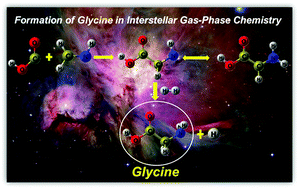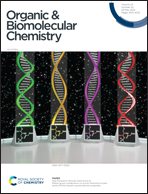Computational studies on the possible formation of glycine via open shell gas-phase chemistry in the interstellar medium†
Abstract
Glycine is the simplest proteinogenic amino acid. It has significant astrobiological implications owing to the ongoing investigation for its detection in the interstellar medium (ISM). Hence, a suitable mechanistic elucidation for its formation in the ISM is of current research interest. In the present work, by employing electronic structure calculations [UCCSD(T) and density functional theory (DFT)], various plausible chemical pathways in the gas phase have been examined for the formation of glycine (whose existence has been indirectly proposed in the ISM) and other simple amino acids (yet to be detected in the ISM) from some simpler molecules present in the ISM. This work suggests that step 1: HO-CO (radical) + CH2NH → NHCH2COOH (radical) and step 2a: NHCH2COOH (radical) + H2 → glycine + H (radical) have very small barriers of 0.14 kcal mol−1 and ∼3 kcal mol−1, respectively (easily surmountable at a temperature of ∼50 K under putative interstellar conditions). Hence this should likely be feasible in interstellar gas-phase chemistry. Therefore, HO-CO (radical), CH2NH, and H2 could be the possible precursors for the formation of glycine (subject to the presence of the HO-CO radical). The energetic information related to the interstellar reactions, and how this work takes the putative interstellar conditions into account are presented. This paper also highlights how a reaction found to be unsuitable for interstellar molecular evolution via surface chemistry could nonetheless occur via gas-phase chemistry. Based on our results, this work also recommends detecting three new open-shell molecules, HO-CO radical, NHCH2COOH radical, and NH2CHCOOH radical, in the ISM.



 Please wait while we load your content...
Please wait while we load your content...